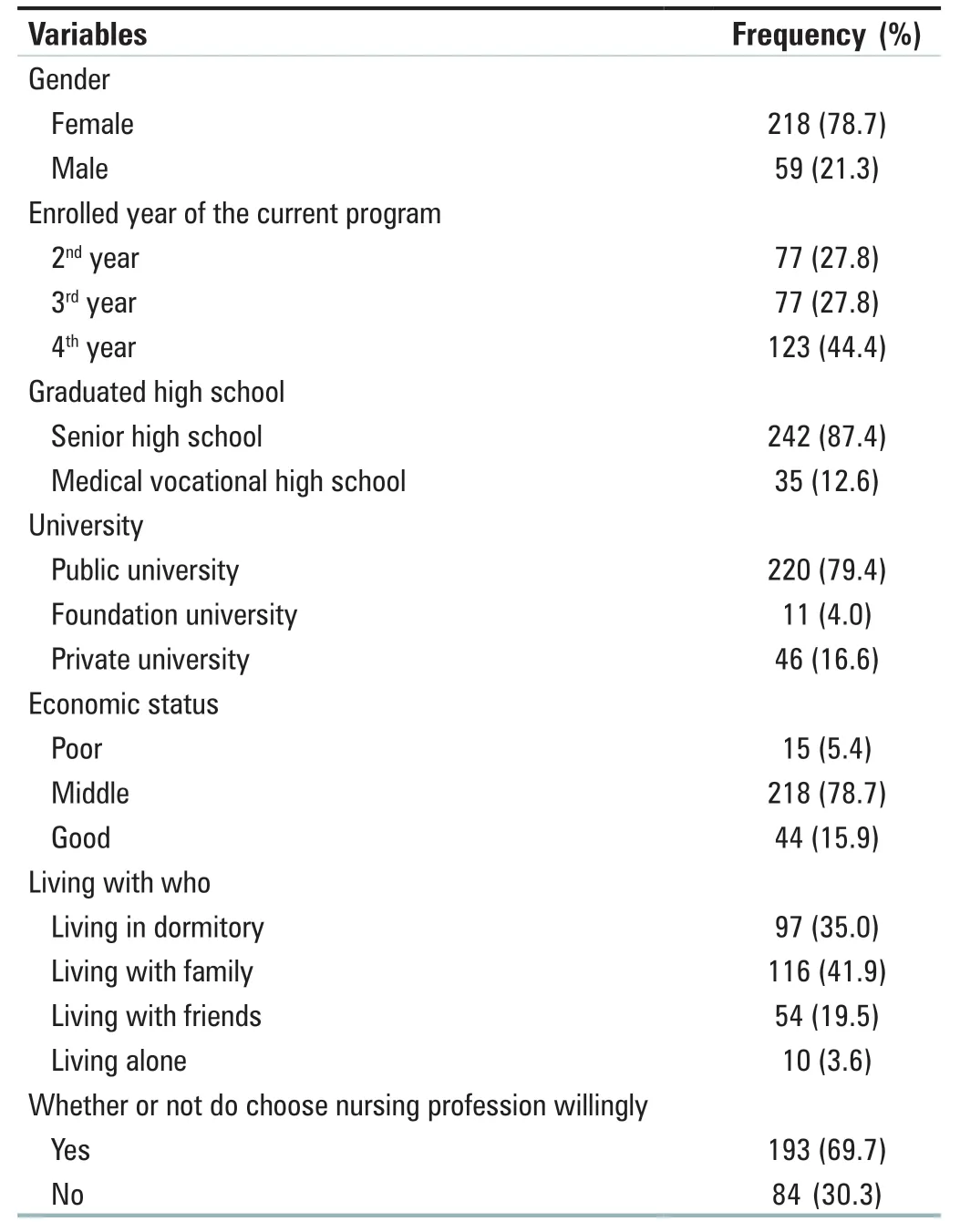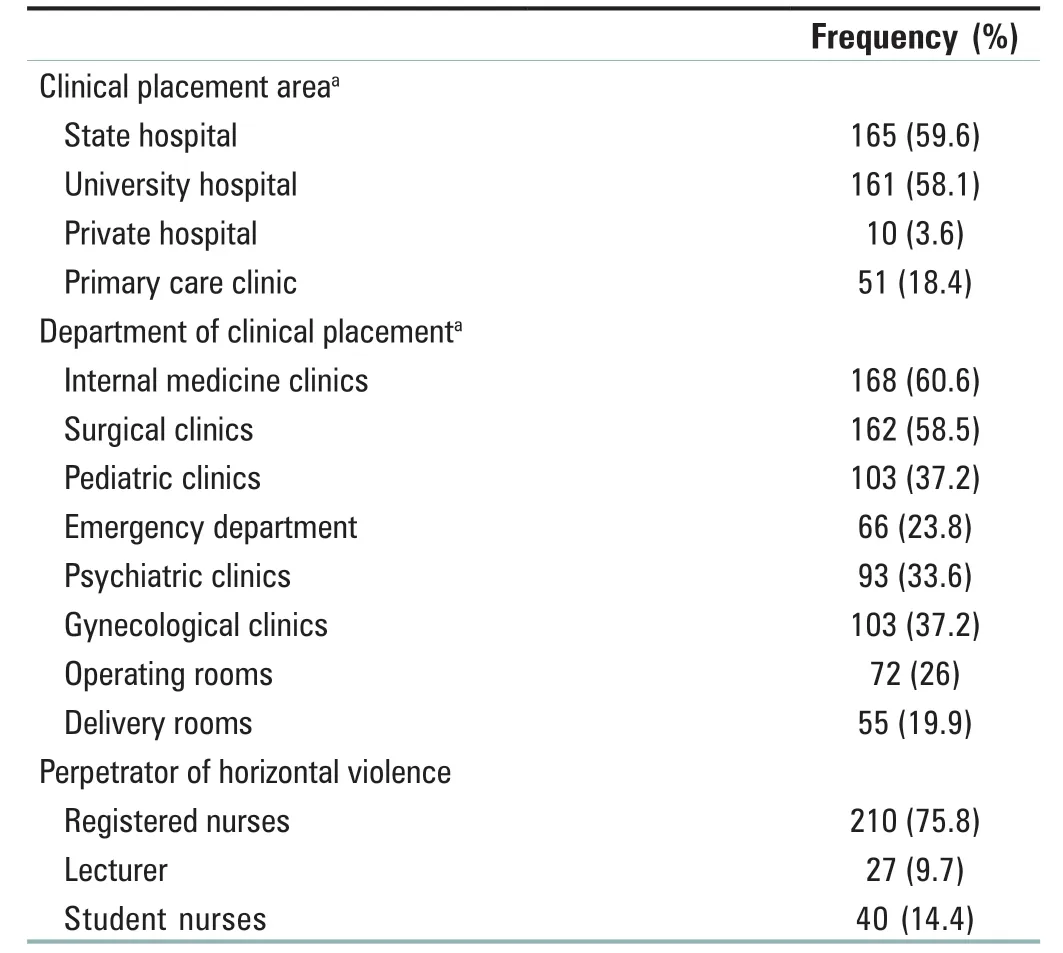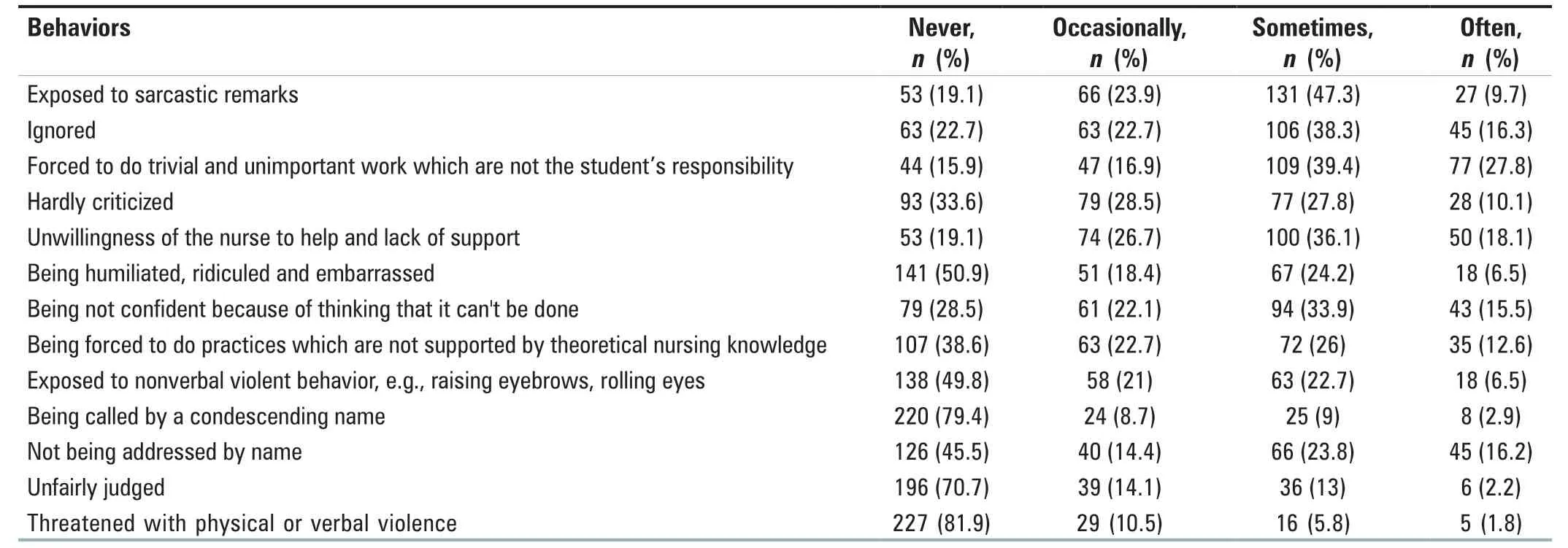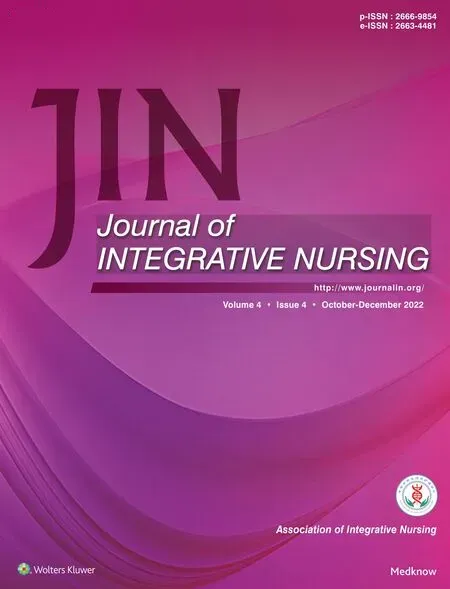Nursing students’ experiences of horizontal violence and occupational belonging during clinical placements
Ozge SUKUT,Cemile Hurrem AYHAN
1Department of Psychiatric and Mental Health Nursing,Istanbul University-Cerrahpasa Florence Nightingale Nursing Faculty,Istanbul,Turkey;2Department of Psychiatric Nursing,Health Science Faculty,Van Yuzuncuyil University,Van,Turkey
ABSTRACT Background: Horizontal violence has negatively affected the students’ active learning,interpersonal relationship,and occupational belonging.However,little attention has been paid to the relationship between horizontal violence and occupational belonging among nursing students.Objective:The objective of this study was to explore the frequency,types,perpetrators,effects,and responses of horizontal violence experienced by nursing students and the relationship between occupational belonging and horizontal violence.Materials and Methods:The present study used a descriptive,cross-sectional survey design.The data were collected from the 277 undergraduate nursing students selected by convenience sampling method using personal characteristics form,horizontal violence survey,and occupational belonging subscale at nursing faculty in Istanbul.Results:The first three horizontal violence behaviors experienced by nursing students were found,respectively: being forced to do trivial and unimportant work which are not the students’ responsibility (84.1%),being exposed to sarcastic remarks by nurses (80.9%) and unwillingness of the nurse to help and lack of support (80.9%) and being ignored by nurses (77.3%).Nearly half of the students (48.4%) considered leaving nursing profession as a result of horizontal violence.There was a negative relation between horizontal violence and occupational belonging (P < 0.05).As horizontal violence scores increased,occupational belonging scores decreased.Conclusions:Findings from this study shown that horizontal violence decreasing occupational belonging,and so nursing students consider leaving nursing profession or education.Further studies are needed to better demonstrate addressing the horizontal violence bilaterally and the effective preventive interventions.
Keywords: Clinical placements,horizontal violence,nursing student,occupational belonging
INTRODUCTION
The phenomenon of violence commonly encountered in the health-care system has occurred in different ways.Coworker/peer violence,which is a term that expresses negative behaviors such as intimidation,disdain,bullying,and hostility applied by a colleague or chief,can also be called horizontal violence and is very common in the health sector.[1,2]Peer violence,also called lateral/horizontal violence (exerted by people with similar status),is defined by the International Nurses Council as a type of behavior that expresses disrespectful and degrading behaviors that damage one’s reputation and value.[3,4]Horizontal violence has prevented healthy communication between health-care professionals,endangered patient safety,and negatively affected the workplace environment.These violent acts that can also take place for undergraduate nursing students are a growing problem and concern in nursing education,nursing practice,and the wider health profession.[4]One of the most important features of nursing education is that students transfer the theoretical knowledge they learned to practice and participate in inpatient care.Clinical placements are known to be effective on learning processes and interpersonal relationships that are critical to the success of nursing students,[5]and provide the opportunity to learn and develop professional nursing skills.[6]
Nursing education covering undergraduate and graduate curriculum in nursing is a process in which students gain knowledge and experience in their nursing career.Horizontal violence,especially for undergraduate nursing students,should disrupt this basis and contribute to the continuation of negative interpersonal relationships in nursing.[7-9]Clinical placement in nursing education constitutes an important part of the education process.It provides the student with the opportunity to put theory into practice and require to develop professional attributes and competencies.[5,9]During the clinical practice,the student nurse’s psychomotor skills (IV,IM,etc.),cognitive field skills (problem-solving,critical thinking,decision-making,etc.),and their qualifications in the sensory field (communication skill,ability to work together,etc.) are revealed.It is very important for undergraduate nursing students who are trained in clinical practice areas to have a supportive attitude by nurses during clinical placement.They should feel safe in health team and provide professional satisfaction in terms of positive clinical practice experience.[10,11]
It has reported that undergraduate nursing students and new graduate nurses are exposed to more peer violence and more sensitive.[12-14]In the study that examined the horizontal violence experienced by undergraduate nursing students in the clinical setting,the participants stated that they were unwanted and ignored in clinics,nurses seem them unreliable,and they also humiliated and blamed student nurses unfairly.[14]As a result of horizontal violence,nursing students accepted this violence as a parade.Hence,they used it to imitate the negative interpersonal relationships they had with nurses in the later stages of their careers.[15,16]Hence,this violence cycle would be able to continue when they graduated.The horizontal violence behaviors that nursing students encounter in their clinical placement have negative effects on students’ physical and psychosocial health.[2,17,18]Violent behaviors encountered in clinical placement should cause dissatisfaction of undergraduate nursing students,and consequently should affect their approach to clinical practice,learning motivations,status of continuing education program,employment options,and intentions to become nurses.[2,19,20]It was also found that bullying behaviors affected negatively students’ motivation for learning and working,so it led to decreased belonging of nursing profession.[17]In another study,student nurses stated that they felt hurt,defeated,confused,misunderstood,insecure,and embarrassed as a result of victim of horizontal violence.[3]It also leads to medication errors,decreased quality of patients’ care,and increase in negative communication.[4,20-22]
The need for belonging has been identified as a basic human need that has a significant impact on cognitive functions,emotional patterns,behavioral responses,health,and well-being.[23,24]When a person lacks a sense of belonging,they will feel lonely and rejected.Belonging is a key notion for mental health since it involves needing,being accepted,and fitting in.[22]One important component of social connections and attachments that supports students’ academic motivation and success is a sense of belonging.Sense of belonging,especially occupational belonging among nursing students,is an important concept that affects students’ acceptance in clinical practice and their interaction with nurses,and may affect students’ clinical learning experiences positively or negatively.[6]Levett-Jones and Lathlean[6]concluded in their study investigated sense of belonging among undergraduate nursing students that sense of belonging is related to their experiences in learning to become a nurse in clinical practice.
In the study that examined the events and meanings of events that impacted the students’ sense of belonging,students stated that they spent more time engaging with registered nurses,and that this significantly affected how they felt about belonging or not.[25]Students’ sense of belonging or connectedness and self-esteem were cultivated when they had an opportunity to meet their educational needs and contribute to the nursing team.It may be difficult for students to fit in if they do not have the chance to develop positive relationships with the nursing teams.[26]Thus,the nature of the interaction between nurses and undergraduate nursing students affects the students’ clinical learning experiences.[10,27]
Although there are many studies focusing on the clinical practice experiences of undergraduate nursing students in the related literature,it has been seen that sense of belonging of undergraduate nursing students is examined in very few studies.However,no study addressing horizontal violence and occupational belonging experiences among undergraduate nursing students has been found.In line with all of this information,this study was conducted to explore the frequency,types,perpetrators,effects,and response of horizontal violence experienced by nursing students and the relationship between occupational belonging and horizontal violence among nursing students.
MATERIALS AND METHODS
Design,sample,and settings
The present study used a descriptive,cross-sectional survey design using an electronic survey (SurveyMonkey.com).An electronic survey was conducted between April and June 2019.A convenience sample method was used.The target population was all students enrolled in a Bachelor of Nursing undergraduate degree in the Nursing Faculty in the 2018-2019 academic year.The sample calculation was not made in the study,and the number of students who filled the questionnaire form between the specified dates and completed at least one clinical experience constituted the sample of the study.Students who completed at least one clinical experience were invited to participate in the study.The students were sent an E-mail about the study and a link to the questionnaire.Researchers reached 328 students,277 of these students filled out the questionnaire completely.
Survey instrument
A horizontal violence survey based on the “Horizontal Violence Workplace Index (HVWI)”[28]was used for evaluating nursing students’ experiences of horizontal violence.The HVWI was modified for the students’ nurse clinical placement environment.The time period was changed from 12 months to 4 months based on education semester.The survey investigated the horizontal violence experienced by nursing students during their clinical placements in terms of type,effect,and response.The survey was evaluated in a five-point Likert type: (1) never (0 times),(2) occasionally (1-2 times),(3)sometimes (3-5 times),and (4) often (>5 times).Participants provided ordinal responses on a five-point Likert scale for each item with a range in frequency of experiencing or witnessing HV behaviors and responses in a 4-month period.The internal reliability of the survey was found 0.93.
Belonging scale
The belonging scale developed by Ersanl? and Ko?yi?it in 2013 is used to evaluate the sense of belonging among university students.It is comprised of 22 questions in three subscales:“family belonging,” “friends group belonging,” and “occupation belonging.” Each item is assessed using a five-point Likert-type scale.In this study,we used only the occupation belonging subscale.The occupation belonging subscale which consists of nine questions is used to evaluate whether students believe they belong in the profession for which they earned their degree.This subscale included items such as “I am excited about the idea of doing the profession I trained,” “I believe that I will be a part of the profession I trained,” and “I am looking forward to doing the profession I trained.”[29]While,in the original study,the Cronbach’s alpha of occupation belonging subscale was 0.88,it was calculated for 0.83 in this study.
Statistical analysis
Survey data were analyzed using the Statistical Package for the Social Sciences (SPSS) Statistics for Windows version 21.0 (Armonk,NY,USA: IBM Corp).The normality distribution of data was evaluated using skewness and kurtosis statistics.In the data analysis process,for the demographic characteristics and horizontal violence experience,descriptive tests were used to represent frequency,percentage,and mean.Simple linear regression was used to determine the relationship between horizontal violence and occupation belonging.A value ofP< 0.05 was considered statistically significant.
Ethical considerations
This study was approved by the Istanbul University-Cerrahpasa Clinical Research Ethics Committee(74311748-302.08.01-191268) on July 1,2020.Participation in this study was voluntary and informed consent was gained from the participants’ first page of the electronic survey.
RESULTS
Demographic and clinical placement characteristics of nursing students
Table 1 shows the detailed demographic characteristics of 277 nursing students.Female accounts for 71.8% (217/277).The mean age of the participants was 21.43 ± 1.73 (18-31 years).44.4% were in their 4thyear.69.7% of the participants reported that they chose the nursing profession voluntarily.
Demographic variables of nursing students
The results showed that 165 (59.6%) stated that they studied in the state hospital while on clinical placement [Table 2].The most reported perpetrator (75.8%) of the horizontal violence was registered nurses who worked their clinical placement.
Clinical placement characteristics Horizontal violence
Table 3 shows 13 different types of horizontal violence experienced by nursing students.The top three horizontal violence experiences were found,respectively: being forced to do trivial and unimportant work which are not the students’ responsibility (84.1%),being exposed to sarcastic remarks by nurses (80.9%) and unwillingness of the nurse to help and lack of support (80.9%),and being ignored by nurses (77.3%).
Frequency of horizontal violence Effect of horizontal violence on nursing students
When investigating the effect of horizontal violence,it was seen that students mostly afraid of to make mistake,so work more harder and more careful (87%),leaving the clinicalplacements with negative feelings and thoughts (77.6%)and reluctant to go to clinical placements (77.3%).50.2%of the students stated that they remained silent,thinking that it would be harmed if they reported the horizontal violence.Furthermore,48.4% of the students considered leaving nursing profession as a result of horizontal violence [Table 4].

Table 1: Demographic variables of the nursing students (n=277)

Table 2: Clinical placement characteristics (n=277)
Effect of horizontal violence on nursing students by frequency Students nurses’ response to horizontal violence
Table 5 shows the response to horizontal violence by frequency for nursing students.When nursing students experienced horizontal violence,88.8% of them shared the situation with friends,family,and another important person.The second most frequent response to horizontal violence was being absent from clinical placement (67.5%).
Response to horizontal violence by frequency The effect of horizontal violence to occupational belonging
Table 6 shows the results of simple linear regression analysis of horizontal violence predicting occupational belonging.The total score on the horizontal violence was a significant predictor of the total score on the occupational belonging scale (F=9.525,P=0.002).Regression equation for simple linear relationship between the variables is “occupational belonging level=36.525 ± 3.064 (frequency of the horizontal violence)”.The adjustedR2value according to the analysis is 0.045.It accounted for 4% of the variance in the total score on the occupational belonging scale.As horizontal violence scores increased,occupational belonging scores decreased.
DISCUSSION
This study demonstrated how traumatic it is for nursing students to witness horizontal violence.All participants stated that they have experienced at least one of the horizontal violence statements.Furthermore,nurses are the most reported perpetrators of horizontal violence which is consistent with prior studies.[30-32]
Nursing students’ horizontal violence term mean abusive behavior of registered nurses.Nursing students are the ones who are unwanted,ignored,and unfairly accused in their clinical placements.[15]Furthermore,behaviors such as bullying,mobbing,aggression,and intimidation are thought as horizontal violence.Hence,the universal definition of horizontal violence experienced by nursing students is unclear in different studies.[30,31,33]In our study,the top three horizontal violence experiences were found: (1) being forced to do trivial and unimportant work which are not the students’ responsibility,(2) exposed to sarcastic remarks and unwillingness of the nurse to help and lack of support,and (3)being ignored by nurses.In the study conducted by Tianet al.,[31]the most violent behaviors experienced by nursing students determined that being forced to do unimportant work,being humiliated by nurses in front of the others,beingforced to do something beyond their ability without guidance among nursing students.[31]In the other study,it was observed that nursing students commonly displayed unfavorable nonverbal behavior,being ignored and alienated from the work team.[32]The study by Kousaret al.[33]revealed that verbal abuse and public humiliation were the most common bullying behaviors reported by nursing students.There is no consensus of horizontal violent behaviors because of lack of the standardized tool which measured the violent,hence the violent behaviors listed in the studies were similar but a bit different.[2,4,21,30,31,34-37]The results of this study are similar to studies using similar measurement tools.[31,34]Although there is a difference in violent behavior in the studies that investigated the horizontal violence,it is a common finding that most of the students were exposed the horizontal violence during their clinical placements.

Table 3: Frequency of horizontal violence (n=277)

Table 4: Effect of horizontal violence on nursing students by frequency (n=277)

Table 5: Response to horizontal violence by frequency (n=277)
In our study,the most reported violent behavior was found being forced to do trivial and unimportant work which are not the students’ responsibility.Taking the role of nursing students in patient care and assigning tasks within the scope of their responsibility increases the self-confidence of nursing students by helping them to develop their skills.[38]Giving students non-responsible tasks have stopped students fromdeveloping the nursing skills they need.Failure of students to acquire the necessary nursing skills causes them to feel inadequate and insecure after graduation.In addition,nursing students might adopt negative behaviors by imitating nurses who are bad role models.

Table 6: The linear regression model of horizontal violence and occupational belonging (n=277)
It was observed that students who were exposed to horizontal violence mostly worked more carefully and hardly because of fear of making mistakes (87%),were reluctant to go to clinical placements (77.3%),and remained silent due to the fear that they would be harmed (50.2%).Moreover,48.4%of the students have thought to leaving nursing professions.Similarly,in another study conducted in Turkey,it was stated that nursing students are reluctant to go to clinical practice as a result of the violence they experience.[39]In another study conducted by Hashimet al.,[40]the consequences of horizontal violence were reported as considering leaving nursing profession or school and negatively affecting the standard of care provided to patients.For effective clinical learning,it is necessary that students need to feel safe during clinical placements.[4,6,41]The reluctant to go to clinical placements of most of the students may decrease the clinical learning motivation of the student and also negatively affect the effective nurse-student communication.
The nurse-student relationship is one of the most important factors affecting clinical learning.[42]Negative communication and low motivation are not only affecting the learning process of the student but also increase the rate of making mistakes because of not communicating.One of the most striking results of the study is that participants remained silent thinking that they would be harmed if they reported the horizontal violence.Remaining silent leads to the normalized process theory has been proven correct as victims of horizontal violence see violent behavior as normal,continuing the cycle of violence.Students take this negative violent behavior as a role model and might reflect it in practice when they become mentors.As a result of the horizontal violence,prospective nurses considering to leave the profession leads to dropouts.This situation also supports the concept of “nurses eat their young.”[4,21,35,43]
It is seen that responses to horizontal violence by students were sharing with friends,family,and another important person and avoiding away from the clinical placement.It is a known phenomenon that individuals respond to fight or flight when faced with a stressor.In this study,moving away from clinical placement demonstrated avoidant coping methods,and discussing the issue with friends,family,and other significant individuals demonstrated emotional problem-solving behavior.Similarly,Wang and Li in their study revealed that nursing students cope with horizontal violence negatively.[44]In case of being exposed to violence,not solving the problem with the related person indicates that problem-solving skills of nursing students should be developed.Clinical educators need to approach this scenario with caution.Students should be encouraged to share their experiences without receiving negative feedback.
Although there are studies investigating that the effect of belonging to the satisfaction of the nursing students and clinical learning environment,there are no studies examining that relation between occupation belonging and horizontal violence.[9,42]According to the results of the current study,horizontal violence decreased the occupational belonging among nursing students.The students' thinking of leaving the nursing profession and education as a result of horizontal violence supports this finding.In order to improve the occupation belonging of nursing students,it is crucial to act as a role model,have a supporting attitude,and enhance student motivation of nurses during clinical placements.[45]As the level of occupation belonging of students increases,their clinical learning levels raise.
Limitation
There are some limitations of the study.First of all,using the convenience sample method,more care should be taken when generalizing the results.Although the results of the study are similar to the literature,there is no standardized tool to measure the horizontal violence.Hence,students’experience of horizontal violence is limited to students’perception.It is recommended that the future research will be carried out by developing standardized tools with randomized samples.In addition,since there is no scale to measure the belongingness,clinical placement experience of nursing students specific to Turkish culture,using the occupational belonging subscale of the general belonging scale in the study is another limitation of the study.Violence is a bilateral phenomenon.Therefore,in the future studies,it is important to consider the phenomenon of horizontal violence both from the perspective of perpetrators and victims.
CONCLUSIONS
It is seen that nursing students experience high rates of horizontal violence and most frequently horizontal violent behavior is forced to do trivial and unimportant work which are not the students’ responsibility as a result of our study.Nursing students felt unsafe as a result of the sarcastic remarks,which caused them to avoid clinical placement.Nursing students normalized this cycle of horizontal violence by remaining silent.As a result of horizontal violence decreasing occupational belonging,nursing students consider leaving nursing profession or school.It is important that nursing students develop the problem-solving skills and express their feelings appropriately and getting support from nurses as a professional mentor.
Nurse educators and mentor nurses play a key role in this process;therefore,both mentor nurses and nurse educators should take responsibility in managing the process.It is seen that increasing students’ self-efficacy by simulation training is also effective in preventing horizontal violence.[46]It is important to carry out studies to strengthen the occupational belonging of nursing students,to compare both perspectives of students and nurses about horizontal violence,and to provide mentor training to guide nurses in order to break the cycle of violence.[8,9]It is recommended to conduct studies that address different aspects of belonging and horizontal violence since occupational belonging of nursing students has a positive impact on factors including patient care,clinical learning,and skill development.
Financial support and sponsorship
Nil.
Conflicts of interest
There are no conflicts of interest.
 Journal of Integrative Nursing2022年4期
Journal of Integrative Nursing2022年4期
- Journal of Integrative Nursing的其它文章
- A simple concept of fluid balance can be harder in the intensive care unit
- Operation rules of scraping technique
- A nurse-led occupational health promotion program for farmers
- Diabetes knowledge and self-care practices among people living with type 2 diabetes mellitus in a diabetes clinic in Southwestern Nigeria
- Job satisfaction and organizational commitment among nurses working on temporary versus permanent jobs at a tertiary care teaching hospital,Uttarakhand,lndia
- Quality of life and psychological impact among chronic disease patients during the COVlD-19 pandemic
